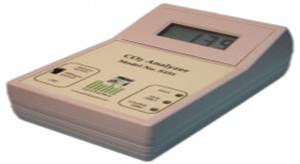I’m a Ph.D. candidate at the University of Hawai’i at Mānoa and my dissertation work asks questions about how corals react to lower pH (associated with ocean acidification, OA) and higher temperature (associated with climate change). I’m one of several people here doing OA research and as a result I have access to fancy gadgets like the one pictured above. The device is an infrared CO2 analyzer which very accurately measures the concentration of CO2 in air pumped through it. We use it in conjunction with a variety of other fancy equipment (fancy = expensive…and nifty) to produce air with precisely controlled concentrations of CO2, which we can then use to aerate aquaria to achieve desired levels of CO2.
Very often in captivity we end up coping with low pH issues in our aquaria, almost always because of high CO2 concentrations in the air in our homes which comes from our own breathing, as well as other sources. This problem is most significant when our homes are closed up for summer air conditioning or winter heating and our CO2 analyzer recently reminded me how significant this issue can be. The average aquarist certainly can’t afford to buy a CO2 analyzer like this one (it runs about $2,450 whereas the entire CO2 control system cost close to $50,000) but I hope my experience below is at least food for thought.
Our system of aquaria for OA work is in a room roughly 30×20 ft with about 15 ft ceilings. It is air conditioned and modestly venilated. Recently I was curious what the CO2 concentration is in the room air so when I arrived at the lab I switched the analyzer on, let it warm up, and used an aquarium pump to deliver room air to the analyzer. Up came the reading: 395 ppm. That’s right about what normal, outdoor air is nowadays so I was satisfied, but I left the air pump and CO2 analyzer going as I began other work in that room. A few minutes later I looked and saw that the analyzer now read 410 ppm. “That’s strange,” I thought, “perhaps the analyzer just wasn’t warmed up.” A short while later: 455 ppm. Hmmm. As I sat and worked in that room, the CO2 concentration in the air climbed higher and higher until it finally reached a plateau after a few hours of my working (and breathing) in the room: 1170 ppm–about three times the concentration of outdoor air!
Let me translate these numbers to something more tangible in an aquarium, the pH. As CO2 dissolves into water in creates carbonic acid, so higher CO2 means lower pH. If we start with normal ocean water (salinity 35 ppt, temperature 77 °F, alkalinity 6.7 dKH) and it is in equilibrium with the air then at 395 ppm CO2, pH = 8.18. Under the same conditions but with 1170 ppm CO2, pH = 7.78–a full 0.4 units lower. That’s a big difference!
When our homes are closed up the CO2 concentration of indoor air can easily reach double, triple, or more the concentration of outdoor air and significantly reduce our aquarium pH. Without getting into the nitty gritty, if the alkalinity of your aquarium water is where you want it (e.g., 7-12 dKH) and the pH is low, there is absolutely no doubt that high CO2 in the water is the problem. Better aeration helps this problem if the air in the room has a much lower CO2 concentration than the water (possible in poorly aerated tanks, but uncommon), but often indoor air has enough CO2 that we have to explore other options to raise tank pH. There are several ways to raise aquarium pH, but first it’s important to be cognizant of this problem. When you’re at home, no, don’t literally hold your breath, but keep an eye on tank pH and understand that if tank pH is low, high indoor CO2 is very likely the source of the problem.











0 Comments